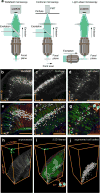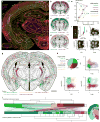An interactive framework for whole-brain maps at cellular resolution
- PMID: 29203898
- PMCID: PMC5994773
- DOI: 10.1038/s41593-017-0027-7
An interactive framework for whole-brain maps at cellular resolution
Erratum in
-
Publisher Correction: An interactive framework for whole-brain maps at cellular resolution.Nat Neurosci. 2018 Jun;21(6):895. doi: 10.1038/s41593-017-0058-0. Nat Neurosci. 2018. PMID: 29255166
Abstract
To deconstruct the architecture and function of brain circuits, it is necessary to generate maps of neuronal connectivity and activity on a whole-brain scale. New methods now enable large-scale mapping of the mouse brain at cellular and subcellular resolution. We developed a framework to automatically annotate, analyze, visualize and easily share whole-brain data at cellular resolution, based on a scale-invariant, interactive mouse brain atlas. This framework enables connectivity and mapping projects in individual laboratories and across imaging platforms, as well as multiplexed quantitative information on the molecular identity of single neurons. As a proof of concept, we generated a comparative connectivity map of five major neuron types in the corticostriatal circuit, as well as an activity-based map to identify hubs mediating the behavioral effects of cocaine. Thus, this computational framework provides the necessary tools to generate brain maps that integrate data from connectivity, neuron identity and function.
Conflict of interest statement
D.F. is a stakeholder in Histohub AB. The other authors declare no competing financial interests.
Figures







References
-
- Denk W, Briggman KL, Helmstaedter M. Structural neurobiology: missing link to a mechanistic understanding of neural computation. Nat. Rev. Neurosci. 2012;13:351–358. - PubMed
Publication types
MeSH terms
Substances
Grants and funding
LinkOut - more resources
Full Text Sources
Other Literature Sources
Molecular Biology Databases
Research Materials

